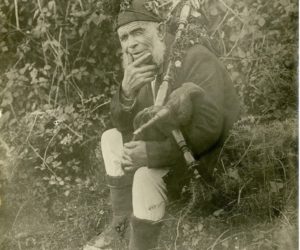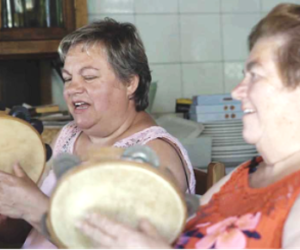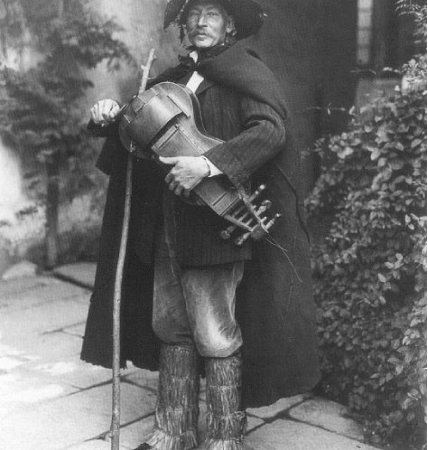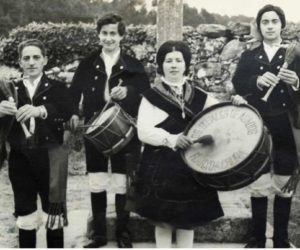Galician traditional music

Historical Background
The creation of the Spanish state was a slow process that began in the 9th century and culminated in the 16th century with the centralization of power in the Crown of Castile, one of the medieval feudal kingdoms in the Iberian Peninsula. Another kingdom was the kingdom of Galicia, where between the 11th and 13th centuries a new language was developed: the Galician language, the basis of a culture with specific traits that attained worldwide prestige in the field of literature. As a result of the changes in the balance of power in the Peninsula, Galician was gradually excluded from official uses and replaced by Castilian, which became the language of the new ruling class that was to hold power in Galicia for the next four hundred years, while Galician remained the language of the illiterate majority of the population.
The 19th century gave rise to a Renaissance of the Galician language and culture and was paralleled by the development of Galician nationalism. This initiated a process of linguistic and cultural normalization that still continues today, influenced by the current trend of globalization. This historical evolution helps us to understand that within today’s Spain, Galicia continues to be a region with a marked cultural personality, manifested not only in its language but also in the field of arts, particularly its music and dance.
Organology
A large variety of instruments are used in Galician traditional music. What follows is a short description of the most representative ones.
Gaita de fol galega (Galician bagpipe)
- It is the most representative melodic instrument in Galician traditional music and has even become a symbol of Galician culture as a whole.
- Nowadays, its bag is made of synthetic materials like Gore-Tex but originally it was made of the stomach or the skin of different animals.
- The drone pipes and the chanter can be made of different types of wood : boxwood, ebony, grenadilla…
- The drones have a single reed whereas the chanter has a double one.
- There are several varieties of the instrument. The number of drones can vary from one to three and there are also gaitas de fol in different pitches, the most frequently used being C.

Pandeireta (Galician tambourine)
- It is a circular percussion instrument made of wood and animal skin with ferreñas (jingles) all around it.
- In the traditional way of playing the instrument, the dominant hand holds the instrument while the other one beats it, making the jingles sound continuously.
- This is the instrument that usually accompanies the Galician female singing.

Zanfona (Hurdy Gurdy)
- This chordophone is closely linked to oral narrative genres (romances), and was traditionally played by blind performers.
- It is a string instrument, with some of them working as melody strings and others as drones. Traditional hurdy gurdies in the Iberian Peninsula had 3 melody strings (G’-G’-G) with drones in G and C. Nowadays, there are other models, also including trompette strings.
- The sound is produced when the strings rub a wheel connected to a handle.

Tamboril (snare drum)
- It is a percussion instrument made of wood with a drumhead of animal skin beaten with drumsticks.
Bombo (bass drum)
- This is a large, round type of drum.
- It is also made of wood and animal skin and it can be beaten on both sides using a single padded drumstick.
- These instruments often come together as accompaniment to the gaitas.

Other melodic instruments such as the requinta (transverse flute made of wood), fiddle, ocarina, trompa da Fonsagrada (jews harp), can be found in specific areas. Besides, clarinet, saxophone, accordion and brass instruments are also played in some ensembles along with the gaita and percussion. On the other hand, it is also typical the use of a variety of kitchen utensils (spoons, tins, frying pans…) and land-labouring tools (hoes) as percussion instruments to accompany the singing.
Genres
The variety of genres in today’s Galician traditional music is the result of a long history. In the second half of the 19th century, when the first song books were appearing, researchers tried to develop a taxonomy in the main genres of popular music, a process that was continued during the 20th century (Carpintero, 2010). In the first half of the 20th century, many processes affected the repertoire, for example, the development of the radio, emigration, the use of music in a functional context to liven up feasts, and the instrumental music, which acquired a special importance through the emergence of the bagpipe quartet.
These circumstances implied the addition of genres of Latin American or Central European origin to the repertoire, and their integration into traditional music with greater or lesser consolidation throughout the 20th century, such as waltz, mazurka, polka, rumba, fox-trot… (Costa, 2004). Some of them are still used, and others became disused in the canon of traditional Galician music.
The genres in Galician vocal and instrumental popular music also acquire a different evolutionary development in musical terms. Although in both traditions you can observe a process of tonalization that reaches our days, in vocal music it is possible to find more traces of modal structures, which refer us to an older origin than the tonal melodies that are present especially in the instrumental repertoire.
Some of the main genres are :
- Muiñeira : One of our main genres, usually in 6/8, vocal and instrumental. Schubart (1995) differentiates between muiñeira nova and muiñeira vella, the first being a product of the late influences mentioned above, and the second an eminently vocal variety that is associated with a tambourine technique in which the fist is used (In some places it is known as muiñeira empuñada because of that technique).
- Xota : It’s a genre in a ternary meter (3/8), and also vocal and instrumental. For some researchers it is a relatively recent genre in the peninsula, that’s why it took some time to be included in Galician song books (Groba, 1997). In the instrumental variety, it usually has two parts: the first one is faster, with smaller figures; and the second one, more lyrical. There are many onomatopoeias associated with this rhythm like: “Ana come pan, de Verín son” (the bolded syllables correspond to the longest values).
- Alalá : Historical genre, vocal, rhythmically free. For some researches there is a connection between the alalá and medieval music (plain chant), because of the common features. At the end of the 19th century, there was a movement of creation of national identity, and from that moment, this became one of the genres that represents the best the essence of Galicianness.
- Pasodoble : Instrumental genre that developed more recently in the twentieth century. It’s in a binary meter (2/4). While xota and muiñeira are dances where the dancing couples perform far apart, in the pasodoble the couples dance together holding each other, just like in other Central European dances such as the waltz or the mazurka.
Costa, L. (1997). “La Música Popular (Cap. 8)”. En Galicia-Antropología (vol. XXV), 403-431. A Coruña: Hércules.
Costa, L. (2004). Las rumbas olvidadas: transculturalidad y etnicización en la música popular gallega. Trans. Revista transcultural de música, (8). https://www.sibetrans.com/trans/articulo/194/las-rumbas-olvidadas-transculturalidad-y-etnicizacion-en-la-musica-popular-gallega
Groba, X. (1997). “El estudio de la música tradicional gallega y el canto de tradición oral (Cap. 6)”. En Galicia-Antropología (vol. XXV), 328-359. A Coruña: Hércules.
Schubarth, D., & Santamarina, A. (1984). Cancioneiro popular galego. A Coruña: Fundación Barrié de la Maza.
Videos
He was a gaita player with a really personal style. He used a lot of ornaments (trills, vibrato, mordents…) in his interpretations. We would also like to share this video because it is a recording of the Alalá program (broadcast on Galician public tv TVG), which is a documentary series about Galician traditional musicians (pipers, tambourine players, folk musicians…). You can easily access this material-channel through this link.
This folk trio play a lullaby against the background of an inland Galician landscape (O Courel Range).
These three women are singing a working song in Galician. They beat a hoe with a stone for percussion.
This panpipe tune played by a Galician pig gelder and compilated by Alan Lomax has inspired an arrangement by the gaita player Marina F. Vigo.
Recorded at the Rianxo Auditorium during the XVIII Zona da Zanfona International Meeting, in the building where the festival courses take place.
On this recording you can see the performers playing a xota rhythm with their pandeiretas while singing.
Gaita, vocal harmonies and electronics come together in this song with feminist lyrics. It is a sample of the emerging trends in Galician root music.
This is a recreation of the field work made by Alan Lomax when he visited Galicia in 1952. It shows the transition from mourning to exhilaration. The musical director of this video is Xurxo Fernandes, a great musician and one of the leading compilators of our traditional music.
Playlist
Reference work
- A Tiracolo. Ouvirmos. https://www.ouvirmos.com/web/catalogo-editorial-4/a-tiracolo-2/
- aCentral Folque, Galician center of popular music. http://www.folque.com/01.140415wp/. Editorial: http://www.folque.com/01.140415wp/tenda/
- Archive of the Oral Heritage of Identity at the Museum of the Galician People. (Arquivo do Patrimonio Oral da Identidade (Apoi) do Museo do pobo galego). http://apoi.museodopobo.gal/.
- Carpintero, Pablo. (2010). Os Instrumentos musicais na tradición galega. http://www.consellodacultura.gal/asg/instrumentos/indice-de-instrumentos/.
- Consello da cultura galega. http://consellodacultura.gal/
- Editorial Canela. https://editorialcanela.gal/es/
- Folkoteca galega. Scores of Galician music. https://folkotecagalega.com/
- Inquedanzas Sonoras. Firm specialized in the edition, distribution and community management of Galician music and music made in Galicia. https://inquedanzas.com/gl/
- López, Carme, Feixoo, Xulia, DePalma, Renée. (2023). Axudádeme a cantar. Serie documental. http://consellodacultura.gal/especiais/axudademe-a-cantar/
- Schubarth, D., & Santamarina, A. (1984). Cancioneiro popular galego. A Coruña: Fundación Barrié de la Maza. https://fundacionbarrie.org/cancioneiro-popular-galego?newlang=english